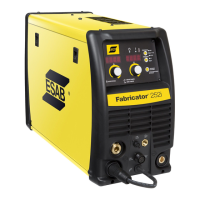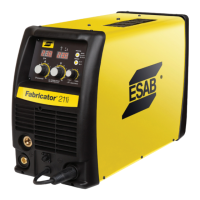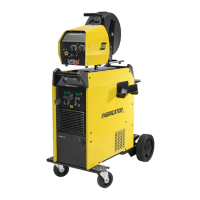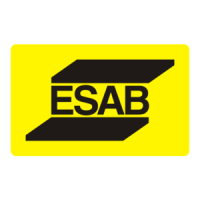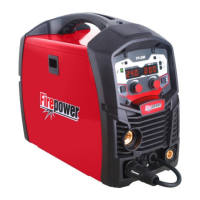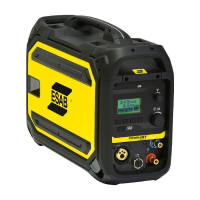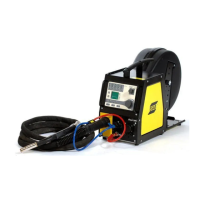ESAB FABRICATOR 141i
Manual 0-5420 4-3 BASIC WELDING GUIDE
When changing to a different electrode wire diameter, different
control settings are required. A thinner electrode wire needs
more Wirespeed to achieve the same current level.
A satisfactory weld cannot be obtained if the Wirespeed and
Voltage settings are not adjusted to suit the electrode wire
diameter and the dimensions of the work piece.
If the Wirespeed is too high for the welding voltage, “stubbing”
will occur as the wire dips into the molten pool and does not
melt. Welding in these conditions normally produces a poor
weld due to lack of fusion. If, however, the welding voltage is
too high, large drops will form on the end of the wire, causing
spatter. The correct setting of voltage and Wirespeed can be
seen in the shape of the weld deposit and heard by a smooth
regular arc sound. Refer to the Weld Guide located on the
inside of the wirefeed compartment door for setup information.
Electrode Wire Size Selection
The choice of Electrode wire size and shielding gas used
depends on the following
• Thickness of the metal to be welded
• Type of joint
• Capacity of the wire feed unit and Power Source
• The amount of penetration required
• The deposition rate required
• The bead prole desired
• The position of welding
• Cost of the wire
Transverse and Longitudinal
Nozzle Axes
Art # A-08998_AB
Longitudinal
Angle
Axis of Weld
Angle
Figure 4-9
Art # A-08999_AC
Nozzle Angle, Right Handed Operator
Leading or “Pushing”
Angle
(Forward Pointing)
Trailing or “Pulling”
Angle
(Backward Pointing)
90°
Figure 4-10
Establishing the Arc and Making Weld Beads
Before attempting to weld on a finished piece of work, it is
recommended that practice welds be made on a sample metal
of the same material as that of the finished piece.
The easiest welding procedure for the beginner to experiment
with MIG welding is the flat position. The equipment is capable
of flat, vertical and overhead positions.
For practicing MIG welding, secure some pieces of 16 ga.
(1.6mm) or 1/8" (3.2mm) mild steel plate 6” (150mm) x 6”
(150mm). Use 0.035” (0.9mm) gas shielded steel or gasless
flux cored wire.
Setting of the Power Source
Power source and Wirefeeder setting requires some practice
by the operator, as the welding plant has two control settings
that have to balance. These are the Wirespeed control (refer
to section 3.10.3) and the welding Voltage Control (refer to
section 3.10.9). The welding current is determined by the
Wirespeed control, the current will increase with increased
Wirespeed, resulting in a shorter arc. Less wire speed will re-
duce the current and lengthen the arc. Increasing the welding
voltage hardly alters the current level, but lengthens the arc.
By decreasing the voltage, a shorter arc is obtained with a little
change in current level.
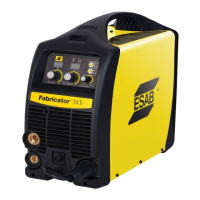
